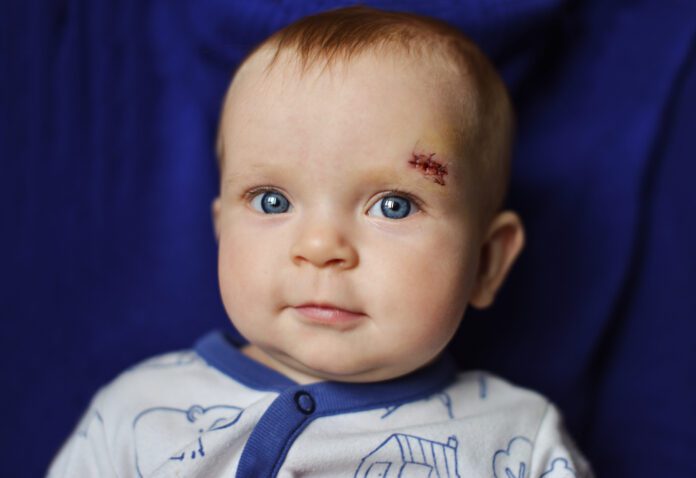Overview
A head injury is any trauma to the scalp, skull, or brain. The injury may be only a minor bump on the skull or a serious brain injury. Head injury can be either closed or open (penetrating).
A closed head injury means you received a hard blow to the head from striking an object, but the object did not break the skull.
An open, or penetrating, head injury means you were hit with an object that broke the skull and entered the brain. This is more likely to happen when you move at high speed, such as going through the windshield during a car accident. It can also happen from a gunshot to the head.
Head injuries include:
Concussion, in which the brain is shaken, is the most common type of traumatic brain injury.
Scalp wounds.
Skull fractures.
Head injuries may cause bleeding:
In the brain tissue
In the layers that surround the brain (subarachnoid hemorrhage, subdural hematoma, extradural hematoma)
Head injury is a common reason for an emergency room visit. A large number of people who suffer head injuries are children. Traumatic brain injury (TBI) accounts for over 1 in 6 injury-related hospital admissions each year.
Cause
Common causes of head injury include:
Accidents at home, work, outdoors, or while playing sports
Falls
Physical assault
Traffic accidents
Most of these injuries are minor because the skull protects the brain. Some injuries are severe enough to require a stay in the hospital.
Symptoms
Head injuries may cause bleeding in the brain tissue and the layers that surround the brain (subarachnoid hemorrhage, subdural hematoma, epidural hematoma).
Symptoms of a head injury can occur right away or may develop slowly over several hours or days. Even if the skull is not fractured, the brain can hit the inside of the skull and be bruised. The head may look fine, but problems could result from bleeding or swelling inside the skull.
The spinal cord is also likely to be injured from falls from a significant height or ejection from a vehicle.
Some head injuries cause changes in brain function. This is called a traumatic brain injury. A concussion is a traumatic brain injury. Symptoms of a concussion can range from mild to severe.
Treatment
Get medical help right away if the person:
Becomes very sleepy
Behaves abnormally, or has a speech that does not make sense
Develops a severe headache or stiff neck
Has a seizure
Has pupils (the dark central part of the eye) of unequal sizes
Is unable to move an arm or leg
Loses consciousness, even briefly
Vomits more than once
Indications of head injury
Then take the following steps:
Check the person’s airway, breathing, and circulation. If necessary, begin rescue breathing and CPR.
If the person’s breathing and heart rate are normal, but the person is unconscious, treat as if there is a spinal injury. Stabilize the head and neck by placing your hands on both sides of the person’s head. Keep the head in line with the spine and prevent movement. Wait for medical help.
Stop any bleeding by firmly pressing a clean cloth on the wound. If the injury is serious, be careful not to move the person’s head. If blood soaks through the cloth, do not remove it. Place another cloth over the first one.
If you suspect a skull fracture, do not apply direct pressure to the bleeding site, and do not remove any debris from the wound. Cover the wound with a sterile gauze dressing.
If the person is vomiting, to prevent choking, roll the person’s head, neck, and body as one unit onto their side. This still protects the spine, which you must always assume is injured in the case of a head injury. Children often vomit once after a head injury. This may not be a problem, but call a doctor for further guidance.
Apply ice packs to swollen areas (cover the ice in a towel so it does not directly touch the skin).
DO NOT Follow these precautions:
DO NOT wash a head wound that is deep or bleeding a lot.
DO NOT remove any object sticking out of a wound.
DO NOT move the person unless absolutely necessary.
DO NOT shake the person if they seem dazed.
DO NOT remove a helmet if you suspect a serious head injury.
DO NOT pick up a fallen child with any sign of head injury.
DO NOT drink alcohol within 48 hours of a serious head injury.
A serious head injury that involves bleeding or brain damage must be treated in a hospital.
For a mild head injury, no treatment may be needed. However, call for medical advice and watch for symptoms of a head injury, which can show up later.
Your health care provider will explain what to expect, how to manage any headaches, how to treat your other symptoms when to return to sports, school, work, and other activities, and signs or symptoms to worry about.
Children will need to be watched and make activity changes.
Adults also need close observation and activity changes.
Both adults and children must follow the provider’s instructions about when it will be possible to return to sports.
Source
Courtesy of MedlinePlus from the National Library of Medicine



